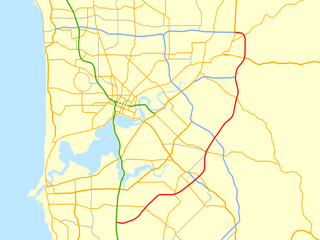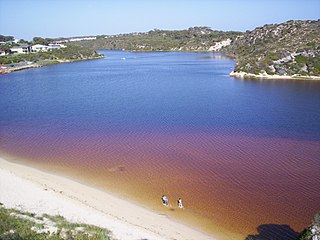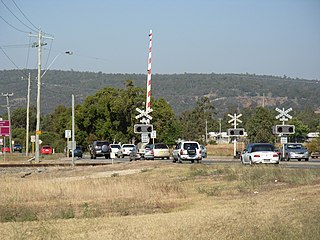
Clackline Brook is an 11.6-kilometre-long (7.2 mi) [1] waterway in the Wheatbelt region of Western Australia. From near Clackline, it runs east-south-easterly towards Mokine, before turning north and ending near Mokine Hill. [1] Clackline Brook joins onto Spencers Brook, with the name changing at the confluence with Corolin Brook. [2] :1

The Wheatbelt is one of nine regions of Western Australia defined as administrative areas for the state's regional development, and a vernacular term for the area converted to agriculture during colonisation. It partially surrounds the Perth metropolitan area, extending north from Perth to the Mid West region, and east to the Goldfields-Esperance region. It is bordered to the south by the South West and Great Southern regions, and to the west by the Indian Ocean, the Perth metropolitan area, and the Peel region. Altogether, it has an area of 154,862 square kilometres (59,793 sq mi).

Clackline is a locality in the Wheatbelt region of Western Australia, about 80 kilometres (50 mi) east-north-east of Perth.
The area around Clackline Brook was where a number of Aboriginal families lived, with their territories defined by the surrounding waterways. The area is likely to still have spiritual and cultural significance, although as of 2002 [update] , there are no sites or communities registered with the Department of Land Administration or the Aboriginal Affairs Department. [2] :1
The Department of Aboriginal Affairs was an Australian government department that existed between December 1972 and March 1990.
European exploration of the Avon region began in 1830, with an expedition inland from Guildford led by Ensign Dale. Shortly thereafter the area was settled and farming began. Northam was gazetted in 1836, and over the next 50 years the surrounding region grew rapidly along with the agricultural industry – primarily wheat, sheep, and cattle farming. Land usage along the waterways has not changed significantly, but there has been a trend towards subdivision into smaller lots for hobby farming. [2] :2
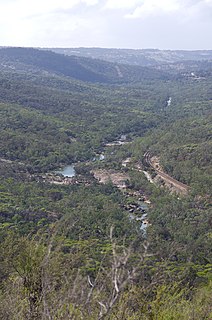
The Avon River is a river in Western Australia. A tributary of the Swan River, the Avon flows 240 kilometres (150 mi) from source to mouth, with a catchment area of 125,000 square kilometres (48,000 sq mi).

Lieutenant Robert Dale was the first European explorer to cross the Darling Range in Western Australia.
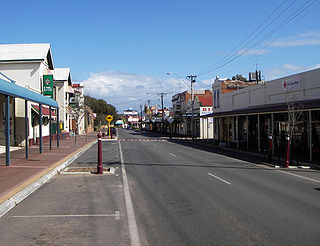
Northam is a town in Western Australia, situated at the confluence of the Avon and Mortlock Rivers, about 97 kilometres (60 mi) east-northeast of Perth in the Avon Valley. At the 2016 census, Northam had a population of 6,548. Northam is the largest town in the Avon region. It is also the largest inland town in the state not founded on mining.
In 1906, the water found to be unsuitable for boiling purposes. A well that had been dug near Clackline Brook was abandoned due to high levels of lime and magnesia salts, and a dam in the brook near the Clackline railway station, meant to provide water for the locomotive engines, was also abandoned. Water was instead sourced from the Coolgardie water supply pipelines. [3]
Great Eastern Highway's bypass of Clackline, including the heritage-listed Clackline Bridge, resulted in Clackline Brook being realigned through a large box culvert. [4]

Great Eastern Highway is a 590-kilometre-long (370 mi) road that links the Western Australian capital of Perth with the city of Kalgoorlie. A key route for road vehicles accessing the eastern Wheatbelt and the Goldfields, it is the western portion of the main road link between Perth and the eastern states of Australia. The highway forms the majority of National Highway 94, although the alignment through the Perth suburbs of Guildford and Midland, and the eastern section between Coolgardie and Kalgoorlie are not included. Various segments form parts of other road routes, including National Route 1, Alternative National Route 94, and State Route 51.

Clackline Bridge is a road bridge in Clackline, Western Australia, 77 kilometres (48 mi) east of Perth in the Shire of Northam, that carried the Great Eastern Highway until 2008. It is the only bridge in Western Australia to have spanned both a waterway and railway, the Clackline Brook and the former Eastern Railway alignment. The mainly timber bridge has a unique curved and sloped design, due to the difficult topography and the route of the former railway. The bridge was designed in 1934 to replace two dangerous rail crossings and a rudimentary water crossing. Construction began in January 1935, and was completed relatively quickly, with the opening ceremony held in August 1935. The bridge has undergone various improvement and maintenance works since then, including widening by three metres (10 ft) in 1959–60, but remained a safety hazard, with increasing severity and numbers of accidents through the 1970s and 1980s. Planning for a highway bypass of Clackline and the Clackline Bridge began in the 1990s, and it was constructed between January 2007 and February 2008. The local community had been concerned that the historic bridge would be lost, but it remains in use as part of the local road network, and has been listed on both the Northam Municipal Heritage Inventory and the Heritage Council of Western Australia's Register of Heritage Places.



